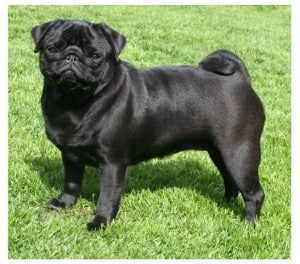Good day and welcome everyone!
This is Sharda with another Pugs newsletter.
Today we will discuss about the Pug Breed Standards to make your pet in show dog form.
Here we go!
Way back in 1885, the American Kennel Club (AKC) first recognized the Pug breed. Today, it is an AKC and FCI recognized dog breed and classified in the Toy Dogs group.
Over the last few years, this breed has grown more popular and is ranked at #15 in the AKC Dog Breeds 2000 Top 50.
All about the Toy Pug Breed: Pug dogs in this Toy category were particularly developed only to bring more comfort and ease to an elite lifestyle, while also amusing the rich. Since the rich first owned them, they soon became status symbols. When European society saw a change in their economy and lifestyles, owning a Pug became more of a pleasure and a symbol of luxury.
General appearance: Its body symmetry and general appearance are a definite square, giving him a stocky appearance. While this is the standard, if your Pug is thin and leggy, or if he has short legs and a long body, they go against the standard.
Size, proportion and substance: As mentioned before, your Pug should ideally be multum in parvo. This would be evident in his compact and proportionate body and tough muscle structure. If he weighs about 6-8 kg, that’s desirable.
Head: If his head is large, bordering on massive but round and without any furrow of the skull, you’ve got yourself a typical Pug. His eyes should be dark, large, bold and prominent and almost globular in shape and sharply offset by a soft and gentle expression. His eyes should also be shiny at peacetime and full of fire, when angry.
Check if his thin and small ears are soft and velvety to touch. Pugs may have either the “rose” kind of ears or the “button,” though the latter is preferable.
While button ears fold over with the fold of the ear level with the top of the skull and do not hang lower than the corner of the eye, rose ears appear smaller and fold with the inner edge of the ear against the side of the head. The latter also gives the Pug’s head a smaller and fuller appearance.
Neck, top line and body: Is his neck slightly arched, strong, thick and long enough for him to carry his head with pride? That’s the demeanour of a typical Pug. If you notice, he has a short back that runs level from the withers to his tail set high.
Besides, his short body is stocky too and consists of a wide chest and well-structured ribs. Set high over his hip is his tightly curled tail, though if it is doubly curled, he conforms to the standard. He should neither have a loose tail that bounces over his back nor an uncurled one.
Forequarters: Your Pug should have strong and straight legs of medium length and set under well. When viewed from the side, are his elbows directly under the withers? If yes, that’s ideal.
His shoulders should ideally be laid back but only moderately so. His pasterns should look strong and should neither be steep nor down. His feet should not be so long that they are neither disproportionate with the rest of his body nor overly round.
He should also boast well split-up toes ending in black nails. Discuss with your vet if the dewclaws are to be removed or not.
Hindquarters: His strong hindquarters will usually reveal a slight bend of stifle and hocks, short but perpendicular to the ground. When viewed from the rear, his legs will appear to be parallel. You will find that usually his hindquarters balance his forequarters, while his thighs and buttocks look not just full but muscular too.
Coat: His coat is usually fine and smooth; short and soft; and glossy though neither hard nor woolly.
Colour: Recognized colours of his coat are silver, apricot-fawn or black. These colours, barring the black, should be decided so that the contrast between the colour, trace and mask are easily evident. Often, fawn Pugs are called “apricot fawn,” “silver fawn” or “stone fawn,” only to differentiate them, but really they are all fawn Pugs.
However, apricot fawns have a peach or apricot tint to the coat which otherwise would have been a clear, cream based one. Alternatively, a fawn coat could also have a mix of black-tipped guard hairs in it, making him look not just darker but “cooler” in colour too.
Markings: The markings on a true-blue Pug dog are clearly defined. You will notice that his muzzle or mask, ears, moles on cheeks, thumb mark or diamond on forehead and the back trace are black. To conform to the standard, he should have a black mask.
The nearer these features are to black, the more well defined and the better. Usually, the trace in a Pug begins in the occipital region and goes on to his tail.
Gait: When viewed from the front, his forelegs should give him a good carriage—one that shows no weakness in his pasterns, with his paws resting squarely ahead with the central toes.
The rear action should be strong and free and generated through hocks and stifles, without any reason to twist or turn in or out at the joints.
The hind legs should move in harmony with the front. You will find that there is a slight natural meeting of the limbs—both front and rear. From a slight roll of his hindquarters, you can expect him to have a free and confident stride, and perhaps just a little jaunty too.
I hope that you learned a lot from today’s Pugs newsletter
All the best and take care
Warmly,
Sharda Baker

